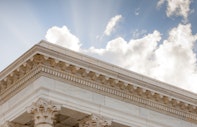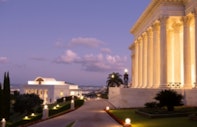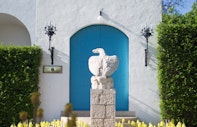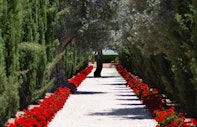What Bahá’ís Believe
Bahá’u’lláh and His Covenant
The Universal House of Justice
The Seat of the
Universal House of Justice
- What Bahá’ís Believe
- Overview
- Bahá’u’lláh and His Covenant
- The Life of the Spirit
- God and His Creation
- Essential Relationships
- Universal Peace
- What Bahá’ís Do
Shoghi Effendi stated that the permanent Seat of the Universal House of Justice would be built on the slopes of Mount Carmel in the vicinity of the Shrine of the Báb and the resting places of members of Bahá’u’lláh’s family. In anticipation, the Guardian developed beautiful gardens around an arc-shaped path, and envisaged a number of edifices destined to serve as the world administrative centre of the Bahá’í Faith.
The Universal House of Justice announced in June 1975 that the time had come to initiate construction of its own permanent Seat, a building that would “not only serve the practical needs of a steadily consolidating administrative centre but will, for centuries to come, stand as a visible expression of the majesty of the divinely ordained institutions of the Administrative Order of Bahá’u’lláh.”The Universal House of Justice, To the Followers of Bahá’u’lláh throughout the World, 5 June 1975 The building was completed and occupied in 1983.
A Harmonizing Style of Architecture
The Seat of the Universal House of Justice stands at the apex of the arc on Mount Carmel. On its eastern side is the permanent building for the institution of the International Teaching Centre. On the other side is the Centre for the Study of the Texts—which houses a library and various offices—and the International Bahá’í Archives building, which contains historical artefacts and precious mementos associated with the Central Figures of the Faith and the early years of the Bahá’í religion.
The importance of the Seat of the Universal House of Justice in relation to the other buildings on the arc is clearly expressed by its location as well as by architectural details, its size and height.
The Seat of the Universal House of Justice
Shoghi Effendi stated that the buildings around the arc were to follow a harmonizing style of architecture, a style which he himself established by building the International Bahá’í Archives in the classical Ionic order. This demanded that the architecture of the remaining buildings be classical, or of a contemporary style incorporating principles of classical architecture; for the Seat of the supreme governing council of the Bahá’í Faith, the stately Corinthian order was adopted.
Tall fluted Corinthian columns adorn the arcade which surrounds the building. At the point of the axis of the arc, at the entrance to the building, there is a portico projecting forward from the colonnade, supported by six additional columns. At the same time the depth and height of the portico recall similar porticos in Persian architecture, and the space it provides gives the impression of inviting all inside. Above the main door through which guests and pilgrims enter, is the spacious window of the chamber in which the Universal House of Justice meets. Facing towards the Shrine of Bahá’u’lláh, it is the heart of the building and is crowned by the dome. Like many domes in eastern architecture, this dome is based on an octagon in the heart of the building itself with an interesting system of integration with the geometry of the length and breadth of the building.
In addition to the Council Chamber of the House of Justice, a reception hall for pilgrims and other important visitors, a conference room, and space for the immediate secretariat of the House of Justice is provided.







